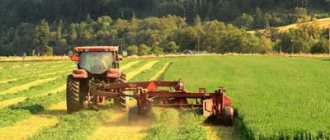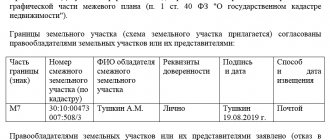Agricultural land is intended for activities related to breeding and grazing livestock, growing various crops. In order to build a cottage on such a plot, which will subsequently be assigned a postal address, the agricultural land must be transferred to individual housing construction. This abbreviation stands for “individual housing construction.” The peculiarity of plots of this type is that they are always located within the boundaries of villages and other settlements. The legislation of the Russian Federation provides that inappropriate use of a site threatens the owner with a fine and, in some cases, confiscation. To prevent this from happening, before starting construction, it is necessary to transfer the land from agricultural use to individual housing construction. We will tell you how to do this further.
What you need to know about land categories and their expanded use
All state lands located on the territory of Russia are classified into categories. This is provided for by the Land Code of the Russian Federation. The division is carried out taking into account the possible method of operation. It must be effective and not cause harm. There are seven categories of land. This is provided for in Article 7 of the RF Land Code. There are lands:
- agricultural purposes;
- settlements;
- special purpose;
- special protected territories (objects);
- forest and water resources;
- stock.
Each site is assigned a specific type of permitted use. They are also enshrined at the legislative level. VRI refers to a permitted activity that can be carried out by a landowner.
The current legislation of the Russian Federation gives Russians the right to own land in populated areas and for agricultural purposes.
The first category allows the construction of residential and other buildings. As for the second, such land can only be used for activities related to agriculture.
It is impossible to build on land where such an opportunity is not provided.
Individual housing construction and agricultural use of land are radically different concepts. Individual housing construction is not a category of land. This is the only permitted way to use it.
It follows from this that a plot allocated for a summer cottage or gardening can be transferred to individual housing construction only if the category of land use is changed. Such a transition is not always possible. This happens due to the remoteness of the site from populated areas. If it is not adjacent to them, then it will not be possible to make changes.
Changing categories of plots is regulated by Federal Law No. 172-FZ of December 21, 2004.
The legislative framework
The change of category is provided for in the special Federal Law on Land Transfer. The conditions, procedures, deadlines for making a decision and reasons for refusal are indicated here. In addition, owners can be guided by the Land Code and the Federal Law on Land Turnover. Some regions have local laws that help you change categories.
Articles and excerpts from laws can become convincing evidence of the need to transfer the category of land from agricultural to individual housing construction.
What types of VRIs are there?
To find out about the type of permitted use of the plot, you need to obtain an extract from the Unified State Register of Real Estate. This is the Unified State Register of Real Estate, where information about all objects is entered. The document will indicate one of the options for operating the site:
- basic;
- conditionally permitted;
- additional.
The transition from the first to the second option is possible only if there are no obvious contraindications. The decision is made by the land use commission. To initiate a public hearing (this is how the issue of changing the VRI is resolved), the owner of the plot needs to submit an application to the municipality. After considering the application, officials prepare a conclusion. If the result is positive, it is reported to Rosreestr and changes are made to the Unified State Register.
Price
The procedure for submitting and considering the application is carried out free of charge , but the preparation of some documents may require payment of a state fee.
So, when independently submitting data to Rosreestr to make changes to the Land Cadastre, you must pay for the following procedures:
- Change information in the Register - from 245 to 350 rubles. For legal entities and individual entrepreneurs the cost is higher - from 700 to 1000 rubles.
- Providing an extract from the Unified State Register of Real Estate (the document is attached to the application sent to the authorities) - from 300 to 750 rubles. - for citizens. For other structures – from 600 to 2200 rubles.
If the rights to the plot are not properly registered, you will have to go through the procedure of land surveying .
After this, cadastral registration occurs with simultaneous registration of the fact of land ownership.
The cost of this procedure varies from 7,000 to 57,000 rubles, depending on the legal status of the customer of the procedure and the area of the site.
You can entrust the change of category and VRI of a land plot to a lawyer; he will tell you exactly how much it will cost. In this case, financial expenses, depending on the complexity of the case, can reach 100 thousand rubles.
Grounds for changing the VRI of agricultural land
How are agricultural lands transferred to individual housing construction? Changing the status is allowed if there are compelling reasons. The decision is made by the local administration. This is due to the fact that as a result of the transition, the cadastral value of the land decreases, which in turn affects state income. The landowner will be required to compensate for the expected losses.
An agricultural land plot will be transferred to the category of land of a populated area only if it falls within the boundaries of a city, village or town. Thus, the transition is possible subject to the following conditions:
- location in close proximity to the boundaries of the settlement (this should be displayed in the general development plan);
- location of the site in territories that are considered as a reserve for expanding the boundaries of a particular settlement;
- not causing damage to the subsoil in the event of construction of a building (there must be a corresponding conclusion from environmentalists);
- absence of other contraindications at the state level.
The status of the allotment changes according to the approved documentation on land management (territorial planning).
Thus, transferring a site to a category allowing individual housing construction is possible only if there is no violation of the requirements of current legislation.
In order to unambiguously answer the question of whether agricultural land can be transferred to individual housing construction, you need to know the type of permitted use of a particular plot. The construction of residential buildings on SkhN lands is permitted provided that the documents indicate one of the types of farming as the site's VRI:
- country house;
- gardening.
After changing the status of the land, the owner will be able to experience a number of benefits. All buildings erected by him will be legalized and officially put into operation. Persons living in the house will be able to obtain permanent registration. In addition, the change in status will significantly increase the value of real estate built on the site.
Alternative: securing the temporary construction site “under individual housing construction” for agricultural land
Changing the land category is a complex and lengthy procedure that does not guarantee a positive outcome and requires significant financial investments. Often, as an alternative way to use agricultural land for individual housing construction, legal confirmation of the permitted use “for individual housing construction” without changing the category.
This procedure is possible if the VRI of the site is “conducting a dacha farm” or “gardening”, as well as if it is possible to change another VRI of the existing agricultural land plot to the above. The procedure for assigning an additional land plot is in many ways similar to changing the purpose of land, but can be modified depending on local legal norms.
Securing an additional VRI does not provide for a reduction in the cadastral value of land, as a result of which there is no need to pay material compensation to the state.
Payment of sick leave after dismissal must be made in the same manner as for a working employee. If a pregnant woman does not work, or her salary is small, then maternity leave can be issued to her husband. You can read a detailed description of how to do this in our article.
Are you currently in a position? Find out how maternity benefits are paid in 2021 by reading this article.
Withdrawal of an allotment from the status of agricultural storage: procedure
Transferring agricultural land to individual housing construction is a complex and lengthy procedure. The owner of the site must submit a corresponding petition to the local authorities. Only the owner of the land has this right. If we are talking about a plot that is in shared ownership, each of the co-owners can contact the municipality. An application in the prescribed form is submitted. It should contain information about:
- cadastral number of the plot;
- purpose;
- categories where the owner wishes to transfer the land;
- reasons for changing status;
- right of ownership.
The cadastral number is indicated in the corresponding passport. If it is not there, you need to contact the representative office of the Federal Service for State Registration, Cadastre and Cartography. This organization keeps records of sites located in the region. To receive the service you must pay a state fee.
The further procedure involves coordination of boundaries, land surveying and drawing up a boundary plan.
After considering the application, local authorities make a decision. If it is positive, the applicant is issued a certificate of transfer of the site from the category of agricultural agricultural use. In case of refusal, the owner is given a document indicating the grounds for making a negative decision.
The procedure for assigning individual housing construction status to land in 2021
The initiator of changing the category of a land property can only be its owner.
The procedure for assigning individual housing construction status to a site consists of several stages:
- Preparation of a package of necessary documents.
- Drawing up and submitting applications to local authorities.
- Consideration of the application. Refusal to accept an application is possible only in two cases: the documents were submitted by an unauthorized person or they do not comply with legal requirements. In the absence of these violations, the application is considered within 2 months.
- Sending a report to the applicant outlining the results of the decision made. There are two options: refusal to satisfy the application or permission to change the category of the site.
How to write an application - sample
The petition for the transfer of agricultural land to individual housing construction is drawn up in free form. The document must contain the following information:
- passport details of the owner of the land property;
- cadastral number of the plot;
- details of documents confirming the applicant’s ownership of the land and the real estate located on it (if any);
- current category and type of permitted use of the site;
- desired category and type of permitted use of the site;
- a statement of the essence of the request and its justification.
It is important to carefully consider the drafting of the text of the application, since if it does not comply with the requirements of regional regulations, consideration of the application may be refused.
To eliminate the possibility of making mistakes when filling out an application, it is recommended to use a ready-made sample document drawn up in accordance with all current legislation.
What documents are needed
The package of documents attached to the application may vary depending on the requirements of local law. But there is a list of certificates that will be required in any case:
- passport of the owner of the land plot;
- documents confirming ownership of a plot of land and buildings located on it;
- cadastral passport and situational plan of the site;
- extract from the Unified State Register of Real Estate.
It is recommended to check with the local administration in advance for a complete list of required documents.
If an incomplete package of papers is submitted or if the certificates do not comply with the established standards, consideration of the application may be refused.
Cost and timing of obtaining an act on changing the status of a site
The cost of obtaining an act of changing the status of a site includes the following expenses:
- registration fee and making appropriate changes to the cadastre - 1,500 rubles;
- costs for obtaining a certificate from Rosreestr - 500 rubles;
- payment for notary services depends on the pricing policy of each individual region and the specific notary office;
- payment for surveyor services - from 10,000 to 50,000 rubles;
- compensation for profits lost by the state - up to 30% of the cadastral valuation amount.
A response on the results of consideration of the application is sent to the owner of the site within 14 days after the relevant decision is made. If a request is refused, the applicant must be provided with clear justification.
If a positive decision is made on the application, the owner of the land is given an act on changing the category and type of permitted use of the site.
The document must contain the following information:
- characteristics and cadastral number of the plot (information must correspond to the data of the title documents for the land and the cadastral passport);
- reasons for making changes;
- the name of the former and newly assigned categories of the site and its type of permitted use.
The changes specified in the act come into force after the relevant data is entered into the State Real Estate Cadastre. This procedure can last up to 2 months from the date of the decision. The owner of the site must be notified of its completion. After receiving this notice, the land owner has the right to begin construction of a residential building on a site that has received the status of an object intended for individual housing construction.
Can they refuse to change the status of agricultural land?
There are a number of reasons why changing the status of agricultural land may be refused. As a rule, it is not possible to transfer agricultural land to individual housing construction if:
- the site is located far from populated areas and does not border them;
- transferring the land to the individual housing construction category is contrary to the general plan;
- the object belongs to a protected zone or has forest inclusions.
If there is an unfounded refusal to change the status of a plot of land, the applicant has the right to challenge this decision in court. If the court considers the plaintiff’s demands motivated and decides to satisfy them, the transfer of the site to another category will be carried out.
Required package of documents
The transfer of land from agricultural use to individual housing construction is carried out on the basis of filing an application and supporting documents. The package consists of:
- copies of the applicant’s identity card (civil passport);
- extracts from the Unified State Register;
- conclusions of environmental impact assessment (provided that this is provided for by law);
- calculation of losses of agricultural production in case of transfer of a plot to another category;
- certificate confirming ownership of the land.
If the legal representative of the landowner applies to local authorities, he must confirm his authority with a notarized power of attorney.
How can I change the allowed use of storage?
Changing the type of use is easier than changing the category. In order for local authorities to authorize such an operation, the following documents must be submitted:
- a statement addressed to the head of the administration of the locality;
- extract from the Unified State Register;
- cadastral plan;
- if there are registered buildings, documents for them;
- area plan, including this land plot;
- situational address plan, where the boundaries of adjacent areas are visible;
- if the land is rented and not owned, then approval from the lessor must be provided;
- copies of certificates establishing land ownership;
- applicant's passport;
- when a representative applies, a power of attorney certified by a notary.
When submitting papers in person or through a representative, request a receipt confirming their receipt. The submitted application must be considered no more than 30 days, unless a hearing is held. Otherwise it will take 2 months.
If the application is approved, in most regions of the Russian Federation, no payment is required. But there are densely populated areas where a cash contribution is required, for example, in the Moscow region.
The VRI is reflected in the Unified State Register extract, so after the procedures for changing the type, you will have to submit a document to change the entry in Rosreestr. This is not difficult, and can be done independently through any MFC.
When the transition is impossible in principle:
- Negative assessment by the environmental service.
- Restrictions related to Federal Legislation.
- The request does not comply with the local development plan. For example, if there are forest lands or a nature reserve nearby, a refusal is possible.
What to do if you refuse?
To achieve results, the decision is challenged in court of any authority. If the court satisfies the applicant’s claim, a transition to a new status will take place. Another option is not to change the status, but to change the possible permitted use - VRI.
The procedure for transferring land, in any case, will take time and require legal preparation. The owner may need to consult a specialist. One way or another, transferring agricultural land to individual housing construction is always profitable, even for the subsequent resale of the property.
Did you find this article helpful? Please share it on social networks: Don't forget to bookmark the Nedvio website. We talk about construction, renovation, and country real estate in an interesting, useful and understandable way.
Refusal to change status: possible grounds
A correctly completed application and a fully completed package of documents do not guarantee that local authorities will make a positive decision. The applicant may expect a refusal. It will be legal and justified if:
- during the environmental assessment a negative decision was made;
- land management documents do not correspond to the intended purpose that the owner of the site wants to achieve;
- In accordance with the current legislation of the Russian Federation, it is impossible to change the status of a specific object.
When making a decision to change the status of agricultural land, officials are guided by a special rule. Transfer to individual housing construction will be impossible provided that the cadastral value of the plot is 50% higher than the regional average. The owner of land containing arable land, pastures and meadows, and perennial orchards will also receive a refusal. Such categories of land are considered especially valuable.
Grounds for changing the category of land
It is possible to change the purpose from agricultural to individual housing construction if:
- the land is not suitable for any kind of farming, but can be used for building houses;
- farming is not economically profitable: for example, it is infertile, rocky, has a sharp relief, etc.;
- the plot is under the rights of lifelong inheritable ownership in the hands of a private person, and he has a desire to build a residential building on this territory for permanent residence;
- other compelling reasons that the owner can convincingly prove. Each case is considered individually.
Why and who might need to change categories
The owner who has decided to build a permanent house on the territory with subsequent permanent residence, obtaining a residence permit and registering the house as a residential property can think about transferring a plot.
A house built on land for agricultural purposes cannot be registered as a separate property. It cannot be sold or mortgaged, since it will only be an outbuilding on the land plot.
This is not always convenient or profitable. The amount of tax, standards for utility bills, etc. also depend on the category of land. The cost of individual housing construction land is higher than that of private plots, therefore, if the owner plans to sell the plot, it will be more profitable for him to change the purpose of the property. However, if registration and obtaining an address are not important, the owner (for example, of a dacha or garden plot) can leave the agricultural category and continue to use the plot for his own needs in accordance with the law.
In what cases is it not necessary to change category?
Moving from one category to another is a long and costly process. Fortunately, it is not always necessary.
There is no need to change the assignment if:
- land marked private household plot is located within the boundaries of the settlement, and not outside it;
- the house has already been built and it meets all the requirements prescribed for residential buildings.
If these conditions are met, you can obtain an address and register in the house without changing the category of the plot on which it is built. This is especially true for former “gardeners” and “summer residents” who have decided to move into a house for permanent residence.
Cost of services and terms of consideration of the application
Every owner of a plot of land who wants to start construction on a plot is concerned with the question of how much it costs to transfer agricultural land to individual housing construction. An extract from Rosreestr will help you answer this question. The service will cost the owner 30% of the figure indicated in the cadastre.
You should also not forget that you will need to prepare a project for building a house and pay for an environmental assessment. Additional costs will be incurred if there is a need to consult a specialized lawyer. The cost of a lawyer’s services will directly depend on what functions he will perform.
As for the processing time for an application, it usually does not exceed 2-3 months. If a negative decision is made, the applicant will be notified earlier. He will receive a refusal within a month.
Advantages of transferring a land plot
Transferring land from agricultural use to individual housing construction in 2021 has a number of advantages:
- the possibility of legal construction of a residential building and its operation;
- guaranteed receipt of permission to register permanently at the place of residence and obtain a postal address;
- connecting the house to utility networks;
- priority right to laying and clearing access roads;
- assigning the status of a residential building to a building, which is accompanied by an increase in the value of the property.
Advantages of individual housing construction
As with individual housing construction, in some cases, agricultural land (for example, belonging to SNT - a gardening non-profit partnership) can be used for housing construction, as well as for subsequent registration. Naturally, the question arises about the advisability of transferring the site to individual housing construction.
The advantages of individual housing construction lands are that they are initially suitable for the construction of residential buildings from scratch; this does not require additional permission from the municipal authorities. Other advantages:
- The installation and repair of communications is carried out by the owners of the plots independently of each other, which exempts them from the mandatory share contribution.
- An individual housing construction plot of land is completely private; its owner does not have to follow the rules of SNT or DNT.
How to translate: instructions
Since construction on agricultural plots is prohibited, it is necessary to change the purpose of the land. To do this, you need to submit a petition, and attach a list of documents to it , which we will consider later.
If the land plot is located far from populated areas, the increase in the boundaries of which is not supported by documents, then the change in purpose will be refused.
The application must provide the following information:
- Grounds allowing for a change of status;
- Full description of the memory;
- The current category of the plot and the name of the category of land plot if the application is granted.
The application is submitted to the cadastral chamber , which will subsequently issue a new cadastral passport.
Information!
After the cadastral passport has been received, it is necessary to make appropriate changes to other documents. These include a certificate of title or a lease agreement.
To do this, you need to contact the Russian Register and write a statement requesting changes.
Differences
| Options | individual housing construction | SNT |
| appointment | construction of a capital structure | agricultural use |
| average price on the market | high | low |
| building permit | required | not required |
| connection of communications | mandatory for a residential building | not necessary |
| tax payments | high land property tax | significantly lower |
| availability of address | full address with house number and street | name of the gardening partnership and plot number |
| opportunity to register for citizens | There is | Yes, subject to certain conditions |








